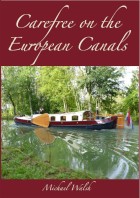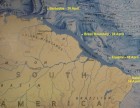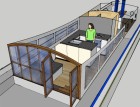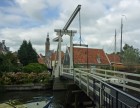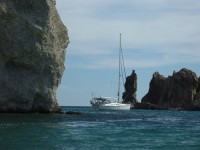Sequitur
Michael & Edi have headed out on a slow, thorough exploration of the globe.
| Vessel Name: | Sequitur and Zonder Zorg |
| Vessel Make/Model: | 2007 Hunter 49 and 1908 Wildschut Skûtsje |
| Hailing Port: | Vancouver, Canada |
| Crew: | Michael Walsh & Edi Gelin |
| About: | For our current location click, on Map & Tracking, then on the Google Earth logo. |
| Extra: | Follow us on Twitter: Follow @YachtSequitur |
| Social: |
13 January 2014
Another New Book Released
I am delighted to announce that my new book: Carefree on the European Canals is now in print and is available on Amazon.com, Amazon.ca [...]
26 April 2013
New Book Released
The proof copy of my new book arrived by courier today. I have approved it and it is now listed on Amazon for pre-order, with a publication date of 30 April. It is a rather large book at 680 pages in an 8.5 by 11 inch format with 315,000 words illustrated by over 2400 colour photos, charts and maps. [...]
24 April 2013
One Year Out of Brazil
One year ago today we sailed Sequitur out of Brazil after enduring more than six weeks in the least-friendly country that we had experienced during our three-year voyage. In the early evening of 24 April 2012 we crossed the line on the chart dividing Brazil from French Guyana and breathed a huge sigh [...]
27 October 2012 | Harlingen, Friesland
Planing a Metamorphosis
We have added a new post to the Zonder Zorg blog at: Planing a Metamorphosis.
29 September 2012 | Sneek, Netherlands
Onward to Friesland
We have arrived in Friesland and have added a new post to the skûtsje's blog at: Onward to Friesland
19 September 2012 | Hoorn, Netherlands
North From Aalsmeer
We have moved northward from Aalsmeer and I have added two new posts: Heading North From Aalsmeer and North From Amsterdam
13 September 2012 | Aalsmeer, Netherlands
Taking Possession
We are back in the Netherlands, and I have added some new posts to the ZonderZorg blog at: Taking Possession and Settling-In and Making Plans
20 August 2012 | Sequitur: St Augustine, USA - Michael & Edi: Vancouver, Canada - Nieuwe Zorg: Aalsmeer, Netherlands
Added a New Website
We have added a new website: Skûtsje ZonderZorg. Zonder zorg in Dutch means without worry. Our intention with the site is to provide a place to share some of the history, geography and culture of the skûtsje as we discover it. We will also use this place to document [...]
11 August 2012 | Sequitur: St Augustine, USA - Michael & Edi: Vancouver, Canada - Nieuwe Zorg: Aalsmeer, Netherlands
Still More Skûtsje History
We continued to attempt to track-down Douwe Albert Visser, who was the owner of Nieuwe Zorg in 1941 when she was re-registered. One of the problems we repeatedly encountered in our online searches was the effect of currently having Albert Visser and two Douwe Vissers as very competitive skûtsje racers, [...]
10 August 2012 | Sequitur: St Augustine, USA - Michael & Edi: Vancouver, Canada - Nieuwe Zorg: Aalsmeer, Netherlands
Some More Skûtsje History
While I was researching the history of Nieuwe Zorg, I finally found her first registration details obscured by an apparent typographical error in a transcribed online spreadsheet. She was listed as having been built in 1901 instead of 1908. I emailed the webmaster of the [...]
Puerto Escondido


The inner basin at Puerto Escondido is a wonderfully protected harbour that can accommodate over 150 boats. Except for a 60 metre wide entrance channel, it is completely encircled by land, and is used by many boaters as a hurricane hole during the summer storm season. Lying immediately adjacent to the inner harbour is a small circular anchorage called The Ellipse, which can hold another fifteen or twenty boats, and outside the entrance channel is The Waiting Room, another protected anchorage, which can hold a another few dozen boats at anchor.

With such fine harbour, it was natural for someone to develop a marina facility. In the mid-70s a marina was built in the Ellipse, but there was no power or water to the floats until 1982. Then in the mid-80s, a joint venture between the Mexican Government and a French investment group began the development of a resort hotel, golf course, condominium and marina complex. The float docks in the Ellipse were removed, destroyed, and never replaced. After a reported 20 million dollars were spent on building inlets and canals, installing an access road, a street grid, electricity and waterworks, the development ground to a halt. Other than the infrastructure, the only remnant from the development is a Trailer and RV park halfway along the two kilometre access road to Highway 1.
In the late 90s, the Mexican Government listed Puerto Escondido in the first phase (2000-2006) of its Escalar Nautica plan under the list of Nuevos Centros Nauticos. About 2003, the quasi-governmental company, Singlar began the development of new facilities with some 40 million pesos. There are now new mooring floats, a fuel dock, dry storage facilities, a laundry, showers, a restaurant, a small tienda, a potable water supply, a wifi antenna and over 100 mooring buoys in the inner harbour. The plan is to complete the marina development, then begin selling building lots.
After lunch we took the dinghy the short distance to the marina floats to check-out the facilities. They are clean, modern and well laid-out. I paid 28 pesos for wireless internet access, and we spent an hour or so getting caught-up on two-and-a-half weeks of emails. I inquired about the mooring rates, and was told a mooring ball would cost us the Canadian equivalent of about $15 per day or $65 per week, and that anchorage in the harbour was at the same rate. The mooring we had tied to was reserved for an arrival later in the day, so we decided against moving to another buoy, and when we finished with our emails, went back out to Sequitur and moved her to an anchorage in The Waiting Room.
After we had anchored, we dinghied back to the marina, and sat in the lounge for three hours or so, enjoying the internet access, and chatting with other boaters. There were five dozen or so boats at anchor and on moorings, most of them rather permanently, and a few, like us, on the way through.
We needed to but fresh produce, and the guidebook recommends the town of Loreto, twenty-five kilometres up the highway. I asked about transportation into town, and learned from one couple of flagging-down buses that go by several times a day on the highway a couple of kilometres away. Another option mentioned was hitch-hiking, another was asking for a shared ride on the 0800 VHF net. One fellow suggested hiring a taxi for the day at $70, but then he added that it made a lot more sense to have Pedro arrange a rental car at $40 per day, all inclusive.
Pedro sounded like the answer. He operates the restaurant and the tienda in the new marina development. He also provides a strong secure connection wifi antenna aimed out across The Ellipse and The Waiting Room anchorages. We took our computers upstairs to the Porto Bello Restaurant and had Pedro subscribe them for a week of wifi service. We then had him book a car for us for shortly before noon on Friday, and we signed-up for his Friday evening filet mignon dinner at 100 pesos per plate.
On Friday morning the men from Hertz arrived with our nearly-new air-conditioned Dodge Attitude, and after a signing ceremony on the trunk lid, we drove off to Loreto. About two-thirds of the way along is the golf resort and condo development of Nopolo. Already rather extensive, the existing resort is the beginning of a fifteen-year, three-billion-dollar development that will see 6,000 homes on 3200 hectares of land along the coast.

In Loreto we stopped to check-out El Pescador, the first of three recommended grocery stores. Then we drove to Fruteria to check it out, and since we had the car parked in the shade, we walked to ISSSTE, the third store on our list. Having compared them all, and decided on our choice, we went exploring in the old town on foot. With a current population of around 10,000, Loreto is the oldest Spanish city on the Baja Peninsula. It was founded by Jesuit missionaries in 1697, and it was the capital of Las Californias from its founding until 1777.

There are many old buildings in the historic centre, and one of them particularly caught our attention. Kitty-corner from the city hall stands a solid-looking, dignified dusky-pink building, now converted into Hotel Posada de los Flores. As we walked into the lobby, we were immediately struck by the architecture and the wonderful play of light coming down from glass bottomed swimming pool, which forms the roof over the central portion of the lobby. The choice of colours, the quality of the finish, the appointments and the accents, all contribute to a very tastefully decorated interior.

We visited the Mision Nuestra Senora de Loreto, which was founded in 1752, and to me, the rather tacky Christmas decorations, which were still up well past the Twelth Day, detracted from the charm of the interior. A better photograph than those which I shot in the church is one of Edi under a sombrero along the rows of small merchants lining both sides of a narrow shopping street. The street, which is shaded by pairs of trees pruned and clipped into oxyoke-shaped arches spanning the throughfare, is obviously oriented to the tourist. Most of the shops carried gaily coloured pottery, or brightly coloured weavings, or sterling silver trinkets, or tacky T-shirts, or a combination of all.

We stopped at a small taqueria for lunch, and as we sat on the patio waiting for our fish tacos to be prepared, a lady from an nearby table heard us speaking English, and came over to ask directions to the beach. She and her husband are fellow Canadians, recently retired and driving south from Vernon British Columbia; they had stopped in Loreto for lunch. We asked them to join us at the table and we had some delightful company as we all ate.
After lunch we went back to the main purpose of our trip to Loreto. We walked back to the ISSSTE to buy some bottles of well-priced Chilean Sauvignon Blanc, and then we recovered our car from the shade in front of the Fruteria. Fruteria is listed as specializing in excellent fresh produce, but they must have had a serious change in management since the guide was written. Their limited selection seemed to us to be mostly culls that were wilted, withered, blemished or otherwise beyond their best-before date.
We drove to El Pescador and found parking on the shaded north side of the building. This smallish supermarket has an adequate selection of produce, and with careful selection we were able to bag a good quantity of acceptable green peppers, pimentos, Roma tomatoes, potatoes, carrots, white onions, Spanish onions, green onions, zucchini, avocados, bananas and apples.
There was a good selection of both packaged and unpackaged meats, as well as frozen, and we bought a couple of kilogram packages of frozen boneless and skinless chicken breasts. We had expected to find a nice selection of fish in a place named El Pescador; we were wrong. There was not one piece of fresh fish to be had, and we bought the only package of frozen fish in the case. We also picked out one of the three packages of frozen shrimp. We'll have to find out where to buy fish here.
On our way back to Puerto Escondido we stopped at the Mini Super in Nopolo. It was a bright, clean and modern facility, with nicely laid-out wide aisles, and complete with refrigerated deli and produce cases. However, the cases were powered-down and empty, and the shelves were stocked mostly with snacks, drinks and convenience foods. We moved on, and next stopped at the small tienda at the RV park on the access road to the marina. It had superior produce to that which we had seen in Loreto, not quite as broad a variety, but what was there was fresher and more select. We topped-up our earlier purchases.
We ferried the load back out to Sequitur and unpackaged, repackaged, washed or cleaned as appropriate, and stowed our purchases in fridges, freezers, lockers, cupboards and drawers. Then we motored back to the dinghy dock and walked up to the restaurant for the steak dinner, arriving at a fashionable ten minutes after the appointed hour.
There were already about thirty people seated when we arrived, and we were signalled by a couple sitting at a four-top to join them. Lisa & John Caruso of Seattle are anchored in their Wauquaiez Pretorian, 'Andiamo' just beyond us in The Waiting Room. They spend half the year cruising down here and the other half living aboard their other boat in Seattle and cruising the Pacific Northwest.
We enjoyed a delightful evening with them as Pedro, his family and his staff prepared and served a delicious filet mignon dinner. Our steaks were perfectly done; the chef hit 'rare' on the nose, and they were surprisingly big, considering the dinner was only 100 Pesos, which is $8.06 Canadian at the prevailing rate. With dinner, Edi and I shared a marvellously complex and well-structured 2004 Anakena Ona Chilean Syrah, which with tip, brought our evening's total to a few cents over $58.
We declared make and mend on both Saturday and Sunday. During my years in the Navy, 'make and mend' was called 'makers' and meant an afternoon off, while remaining onboard and available if required. The term derives from the Royal Navy in the days of sail and oaken ships, when the sailors would from time to time be releived of their off-watch routine to 'make and mend' their uniforms, which were not then supplied by the Navy.
Our make and mend had more to do with tending to the repair and maintenance of Sequitur. On Saturday, after some manual interpretation, I overcame a 'salinity probe failed' alarm on the watermaker, and we made another four hours of water. Edi rearranged the pantry and storeroom, and found the missing toilet paper and twenty kilos of basmati rice, among other things of which we had lost track. She did not; however, find the missing 8.6 litres of artichoke hearts.

On Sunday Edi ran a couple of loads of laundry through the machine and hung them out to dry in the pleasant breeze and 25 degree afternoon sun. I troubleshot the new Magnum inverter/charger, trying to determine why it thinks the house bank is full when the trusty old LinkPro monitor told me it is only 78.5% charged. Finally, after running through a series of tests, I realized that it was simply that the LinkPro needed re-synchronizing. Duh! A bit less klutzily, I re-glued a locker door from the sea cabin. It appears it had been left unlocked, and last week's heavy seas had popped it open and slammed it around an adjacent edge, levering apart three of its corner joints.

After breakfast on Monday morning we took the dinghy the short distance across to the rocky beach at the base of the ridge to the north of us and secured its painter to a large rock. Then we climbed up through the scrub and cacti to the top of the ridge, and scrambled along it to the summit overlooking Puerto Escondido, and then out ridge spurs to shoot some pictures. After a couple of hours of scrambling up and down a circuitous route, we arrived back at the rocky beach a couple of hundred metres away from the dinghy, where we were met by Kip in his dinghy. Kip and Mary are anchored a short distance away from Sequitur, and he had come over to offer us a ride back to our dinghy, and to invite us over to their boat for sundowners.

